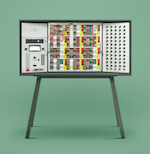A gorgeous guide to the earliest computers

by Sarah Emerson, Motherboard.com
Technology’s evolution of slim, sleek gadgetry is directly proportional to our appreciation for the computing behemoths of yonder years. Sure, the new MacBook Pro is razor thin and beautifully beveled, but it’ll never fill the giant, rectangular hole in your heart left by the 25-pound Osborne 1—the world’s first truly portable computer.
Technology’s evolution of slim, sleek gadgetry is directly proportional to our appreciation for the computing behemoths of yonder years. Sure, the new MacBook Pro is razor thin and beautifully beveled, but it’ll never fill the giant, rectangular hole in your heart left by the 25-pound Osborne 1—the world’s first truly portable computer.
It’s easy to believe the fallacy that early computers forwent form for function, but the Brutalist aesthetic of mid to late-century technology remains a testament to designers’ creativity in an era of challenging limitations. As much pieces of artwork as utilitarian devices, the assertive shapes of primitive computers seemed to indicate a forceful trajectory forward toward a golden age of computing. Even today, retro-futurism continues to enchant and inspire modern artists, and pull our imaginations back in time.
Now, for anyone waxing nostalgic over ancient mainframes and analog machines, London production studio INK has just released a gorgeous photo series called Guide to Computing that’ll make you want to trade your Chromebook for a Harwell Dekatron.
Through delicate retouching and post-production techniques, photographer James Ball (aka Docubyte) breathed new life into these aging historical artifacts. Displayed in a manner reminiscent of 1960s advertising, the Guide to Computing presents these devices as they might have been marketing during their heydays. A few of them even predated the advent of modern color photography.
Most of these machines have never been seen before in this context, so enjoy this spectacularly retro piece of early computing history.




